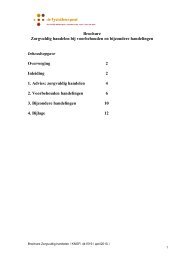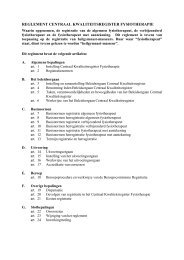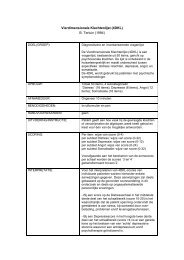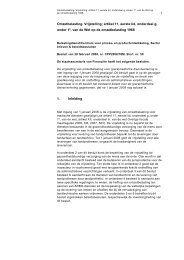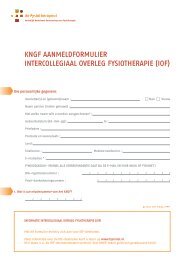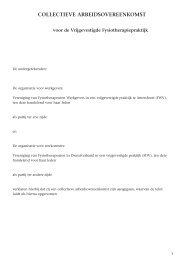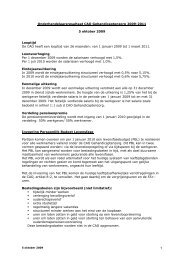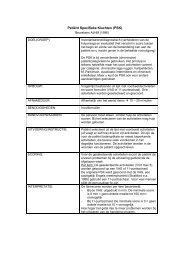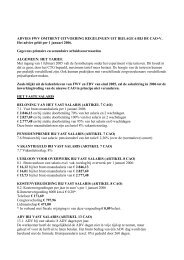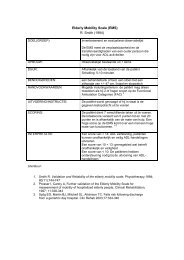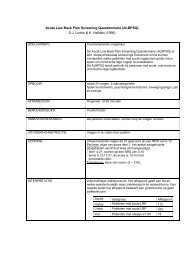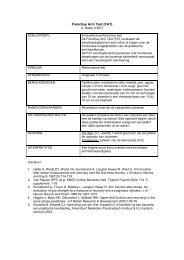Acupuncture and dry-needling for low back pain (Review)
Acupuncture and dry-needling for low back pain (Review)
Acupuncture and dry-needling for low back pain (Review)
Create successful ePaper yourself
Turn your PDF publications into a flip-book with our unique Google optimized e-Paper software.
ack <strong>pain</strong>. The average improvement in <strong>pain</strong> with acupuncture<br />
<strong>for</strong> acute <strong>low</strong>-<strong>back</strong> <strong>pain</strong> was 52% (based on two studies), 32% <strong>for</strong><br />
chronic (16 studies) <strong>and</strong> 51% <strong>for</strong> unknown or mixed durations of<br />
<strong>pain</strong>s (eight studies). The average improvement of <strong>pain</strong> with no<br />
treatment was 6% (six studies). The average improvement of <strong>pain</strong><br />
with sham or placebo therapies was 22% <strong>for</strong> acute (one study),<br />
23% <strong>for</strong> chronic (six studies) <strong>and</strong> 25% <strong>for</strong> unknown or mixed<br />
durations of <strong>pain</strong> (three studies).<br />
ADEQUACY OF ACUPUNCTURE<br />
The results are shown in Table 5. In all trials, acupuncture was<br />
judged to be adequate <strong>for</strong> the population they included.<br />
PRIMARY ANALYSES<br />
1. <strong>Acupuncture</strong> compared to no treatment, placebo or sham<br />
therapy<br />
See Figure 1.<br />
Figure 1.<br />
<strong>Acupuncture</strong> compared to no treatment, placebo or sham therapy<br />
1a. <strong>Acupuncture</strong> versus no treatment <strong>for</strong> acute <strong>low</strong>-<strong>back</strong> <strong>pain</strong>:<br />
There is no evidence because we did not find any RCT <strong>for</strong> this<br />
comparison.<br />
1b. <strong>Acupuncture</strong> versus sham therapy <strong>for</strong> acute <strong>low</strong>-<strong>back</strong> <strong>pain</strong>:<br />
We found only one RCT <strong>and</strong> it used only one session of bilateral<br />
acupuncture on the SI3 acupoint. There<strong>for</strong>e, there is moderate<br />
evidence (one higher quality trial, 40 people) (Araki 2001) that<br />
there is no difference in <strong>pain</strong> <strong>and</strong> function, between one session<br />
of acupuncture on the SI3 acupoint bilaterally <strong>and</strong> sham <strong>needling</strong><br />
of the same point immediately after the session.<br />
1c. <strong>Acupuncture</strong> versus no treatment <strong>for</strong> chronic <strong>low</strong>-<strong>back</strong><br />
<strong>pain</strong>:<br />
The pooled analysis of two <strong>low</strong>er quality trials (90 people) (Coan<br />
1980; Thomas 1994) shows that acupuncture is more effective<br />
than no treatment <strong>for</strong> patients with chronic <strong>low</strong>-<strong>back</strong> <strong>pain</strong> <strong>for</strong><br />
short term <strong>pain</strong> relief, with a SMD of -0.73 (95% CI -1.19 to -<br />
0.28) (See comparison 4.1). There is limited evidence (one <strong>low</strong>er<br />
quality trial, 40 people) (Thomas 1994) that acupuncture is also<br />
more effective at intermediate fol<strong>low</strong>-up <strong>for</strong> outcomes of <strong>pain</strong>. The<br />
pooled analysis of two <strong>low</strong>er quality trials (90 people) (Coan 1980;<br />
Thomas 1994) shows that acupuncture is more effective than no<br />
treatment <strong>for</strong> patients with chronic <strong>low</strong>-<strong>back</strong> <strong>pain</strong> in short-term<br />
functional improvement, with an effect size of 0.63 (95% CI 0.19<br />
to 1.08) (comparison 4.5). There is limited evidence (one <strong>low</strong>er<br />
quality trial, 40 people) (Thomas 1994) that there is no difference<br />
at the intermediate-term fol<strong>low</strong>-up in functional outcome,<br />
<strong>Acupuncture</strong> <strong>and</strong> <strong>dry</strong>-<strong>needling</strong> <strong>for</strong> <strong>low</strong> <strong>back</strong> <strong>pain</strong> (<strong>Review</strong>)<br />
Copyright © 2011 The Cochrane Collaboration. Published by John Wiley & Sons, Ltd.<br />
7



